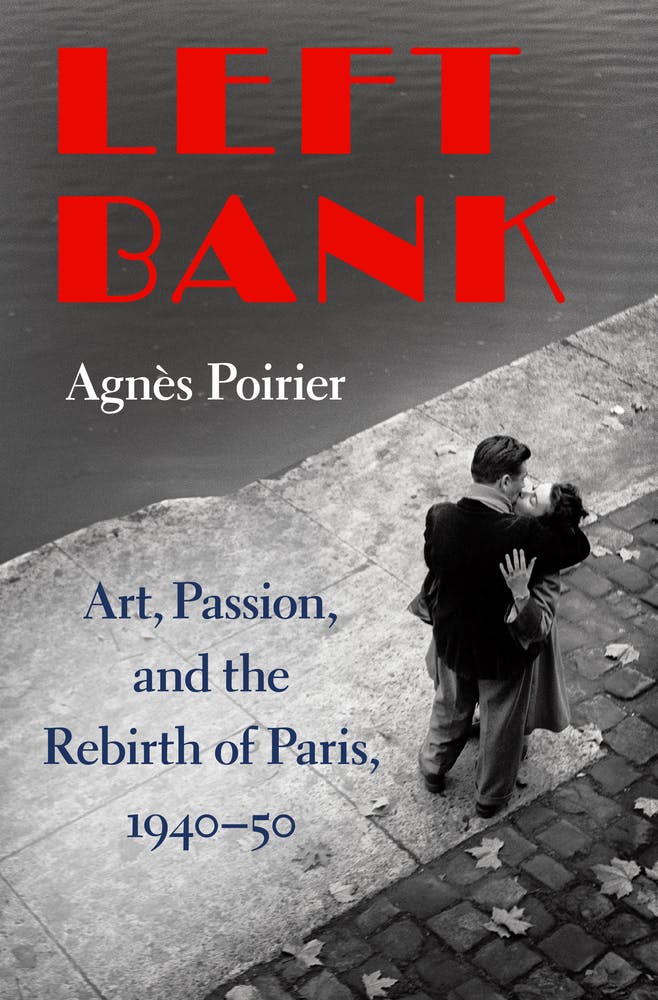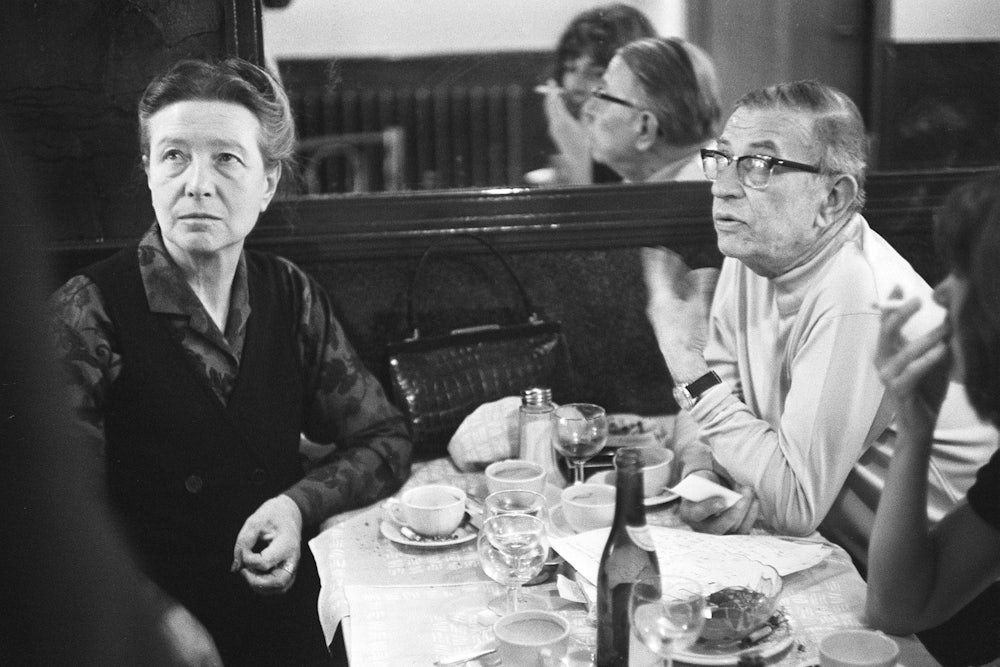Before she became a sultry chanteuse, Juliette Gréco was a prisoner in occupied France. Arrested by the Gestapo in 1943, Gréco spent several months at Fresnes Prison outside Paris. When released, during “one of the coldest autumns on record,” she walked eight miles back to the city in only the cotton dress and sandals she’d been wearing when she was arrested. “I stayed in bed for the next two years,” she said later, though of course that wasn’t entirely true. Like many others, Gréco actually spent months living in a tiny hotel room, haunting the cafés of the Left Bank, near-starving and always cold, dressed in men’s clothing donated to her by friends.

Gréco’s mother and sister, active in the Résistance, had been taken to Ravensbrück, the women’s concentration camp. In the months after the war ended, Gréco went daily to the Lutétia hotel—then being used as a repatriation center for returning prisoners and refugees—for information on their whereabouts. Finally, one day in 1945, she spotted their hollowed faces in the crowd. “For the first few weeks I fed my older sister milk and tiny pieces of food the way you do a kitten,” she said.
It is easy to believe, as I did before reading Agnes Poirier’s Left Bank: Art, Passion, and the Rebirth of Paris, 1940-1950, that everything has already been written about the fabled southern bank of Paris’s Seine River. But most works focus on the Rive Gauche of the Années folles—France’s Roaring Twenties—when it was the site of a fevered flowering of interwar bohemianism, a second home to expatriate writers like Ernest Hemingway and F. Scott Fitzgerald. The decade this volume focuses on is even richer, and Poirier, a Paris-born, London-based journalist, paints a richly detailed portrait of the moment that feels somehow decadent, despite being largely a tale of deprivation.
Parisians huddle in overcoats sipping stew made of carrots and parsnips, the only available vegetables. The Pérodos, a cheap jazz club in the basement of a modest hotel, is a favorite haunt of Gréco’s because it serves orangeade with saccharine. The myth of a kind of frenzied creative productivity is balanced here with slow, cloudy afternoons at the Café de Flore and anecdotes about Beckett and his French friend and would-be translator Alfred Péron, playing lunchtime tennis matches rather than talk shop.
World War II fomented new intellectual, artistic, and philosophical projects, as poets, painters, and philosophers debated the social and political utility of the arts and the future of politics in publications like the underground paper Combat, edited by Albert Camus, and the journal Les Temps Modernes, founded by Jean-Paul Sartre. It was an era of -isms—fascism and communism, existentialism and feminism. In illuminating the linkages among a cast of notable figures and institutions, Poirier brings this complex world to life, showing surprising and intimate connections. At its heart, this is a book about big ideas exchanged over small cups of espresso—or in the case of occupied Paris, ersatz coffee brewed from burnt barley.
Because of the book’s focus on Jean-Paul Sartre, Simone de Beauvoir, and Albert Camus, existentialism in particular emerges as an organic, even obvious outgrowth of these authors’ experiences of the war. In Sartre’s view, for example, the fundamental conflicts underlying human existence were laid bare by the extreme nature of the occupation. The “often atrocious” circumstances of the war, he wrote, “allowed us to live openly this torn and unbearable situation one calls the Human Condition.” Similarly, communism, Poirier writes, exerted a kind of “spiritual power over the youth and the intelligentsia” during this time, serving as a “conscience, a magnet”—which makes a lot of sense when balanced against the lived experience of fascism and collaboration.
For those who love to dish about literary figures, Left Bank reads as an erudite and deeply satisfying gossip column, in which each story is more incredible than the last. When the action opens, Jacques Jaujard, deputy head of the Louvre, is packing up the contents of the museum in order to spare France’s art collection from Nazi pillage. He organizes their clandestine transport in a 203-vehicle convoy to castles throughout the country, where the masterpieces will sit out the war. The Mona Lisa, in a white case marked with three red circles, travels in an ambulance. When the resistance sends a liaison named Mozart to Jaujard’s office in 1944, he is surprised to discover that she’s a “forty-year-old platinum blonde” and former film star, Jeanne Boitel. The two become lovers within days.
As a bulwark against chaos, uncertainty, and the threat of death, sex takes center stage during the war. It’s a distraction and a reliable way of keeping warm. Then comes the liberation of Paris in August of 1944—a scene of jubilation—and untrammeled desire, like electricity, powers the City of Light as it groans back to life. Poirier is careful to capture the wolfish sexuality of both men and women, since some of the relationships she describes were clearly exploitative of some people even as they were liberating for others. The turtlenecked youth of Paris are absolutely besotted with Jean-Paul Sartre, or Simone de Beauvoir, sometimes both, and the pair partake freely. Gerhard Heller, a German editor and censor, has a months-long relationship with a fifteen-year-old girl. When she disappears suddenly, he replaces her with a working-class teenage boy, whom he takes to the opera on Christmas Day.
Men hovering around forty fall regularly for nineteen and twenty-year-old women, and, living “trompe l’oeil existences,” crush the lives around them, Poirier writes. Arthur Koestler, author of Darkness at Noon, spends a violently passionate—or maybe just violent?—night with de Beauvoir, while Camus falls in love with Koestler’s wife, Mamaine. Though some of the trysts Poirier details are entertaining, many are deeply unglamorous. More often, the sexual dramas playing out throughout the book seem chaotic and cold-blooded.
Though Poirier’s writing is both elegant and efficient, the text is anchored by a few other important voices. One belongs to Janet Flanner, longtime American correspondent for the New Yorker, whose sumptuous prose fills out Poirier’s descriptions. It’s Flanner’s words that capture the powerful, if inaccurate, vision of Paris that had taken hold among young Americans and described how they were now flocking to the city. “The Café de Flore serves as a drugstore for pretty upstate girls in unbecoming blue denim pants,” Flanner wrote in 1948, “and their Middle Western dates, most of whom are growing hasty Beaux-Arts beards.” Many were students traveling on the GI Bill, who saw the French city as the world capital of libertinism. In music and film, and in new publications catering to an American postwar public hungry for leisure, Paris was billed as the epicenter of art, fashion, and sex.
With the end of the war, Sartre and de Beauvoir’s journal Les Temps Modernes continued to alienate the Communists, and Sartre and Koestler launched an ill-fated political party. De Beauvoir had a charged affair with American novelist Nelson Algren. Poirier’s cast grows to include the American writers Richard Wright, James Baldwin, and Saul Bellow, who among many others came to live and write in Paris in the late 1940s and 50s. And toward the end of the book, the Marshall Plan began to change the face of Europe, and the Left Bank saw a “mass exodus.” Writers like Norman Mailer and Richard Wright left thinking “cinema was the future.” De Beauvoir departed in pursuit of love, and Camus “escaped Parisian domestic life” and the tedium of politics for a tour through South America.
Left Bank is deeply researched, but Poirier’s narrative suffers for its failure to reckon meaningfully with the extent of the war’s horrors, particularly industrialized murder on an unprecedented scale. Poirier occasionally writes with a disconcerting levity, referring to atrocities of the time in grand—and indirect—terms as the “caprices of history.” She writes breezily of Ernst Jünger, a decorated German soldier who served in an administrative capacity in Paris during WWII and who was assigned the task of translating farewell letters written by thousands of civilian hostages, who were executed by the Germans. It was “dreary work,” according to Poirier, following which Jünger would “chase rare editions” at secondhand booksellers along the Seine before meeting Parisian friends for dinner. But she does not state that it was inhuman work, or place it in the context of the wartime death machine.
In chronicling the Left Bank, Poirier is more interested in the romance of wartime paradoxes, the tensions of collaboration and resistance, freedom and subjugation, glamour and terror. “We were never freer than during the German occupation,” Sartre wrote. That sentiment as much as any conveys the spirit of this collection of individuals, whose style—a powerful combination of caprice and gravitas—set the pace of the dance for decades to come. In this book, which aims to be “a collage of images, a kaleidoscope of destinies,” Poirier succeeds in constructing a sense of how Paris may have felt during those years.
